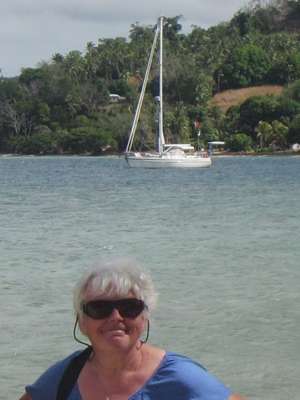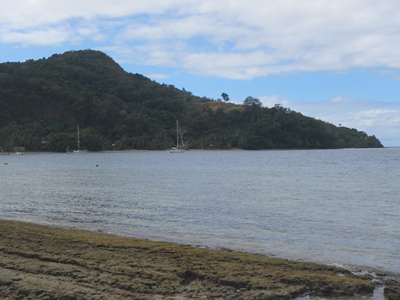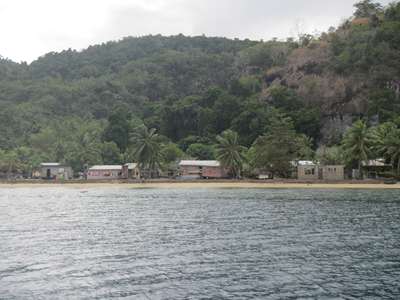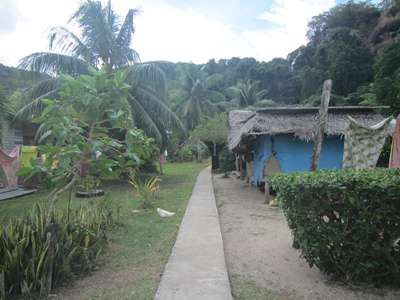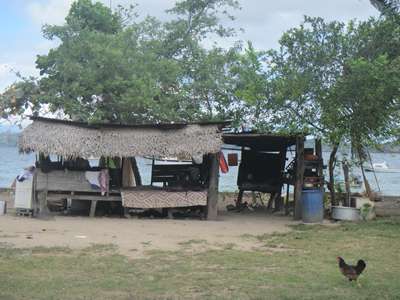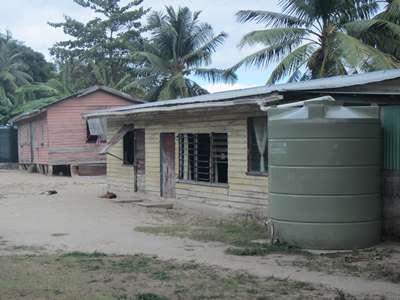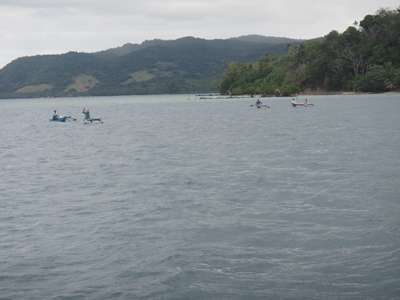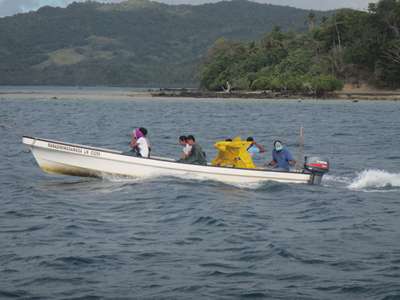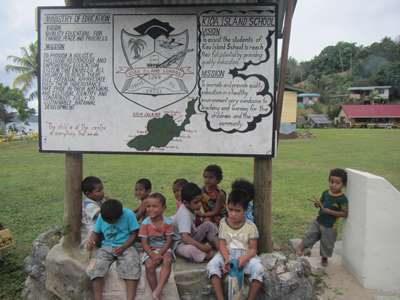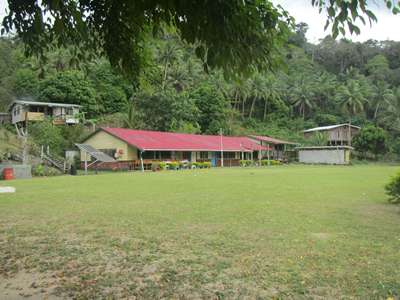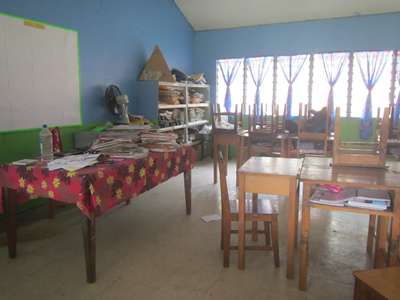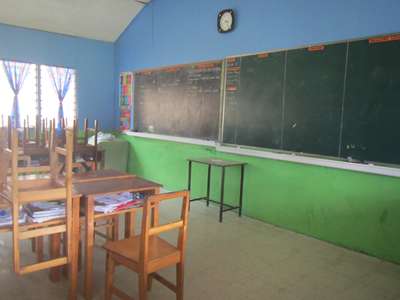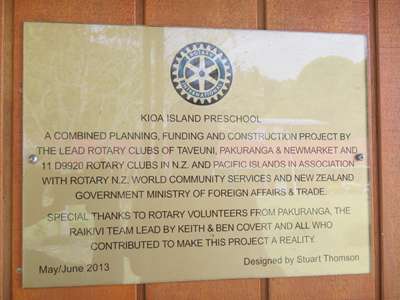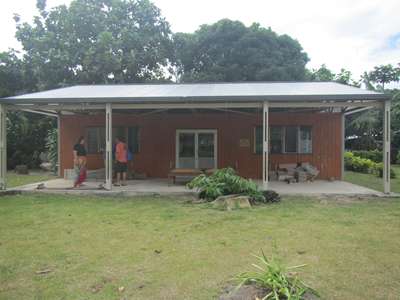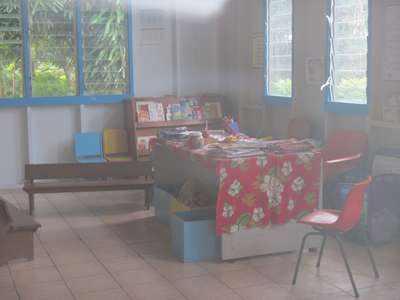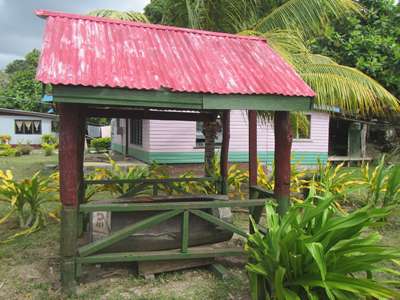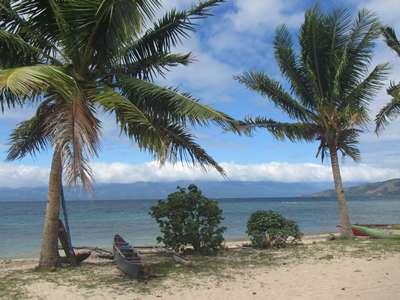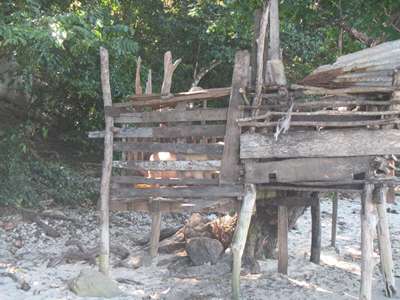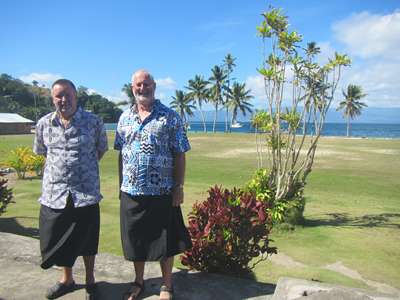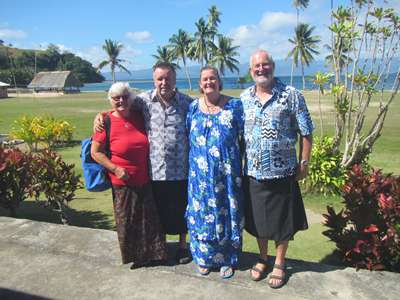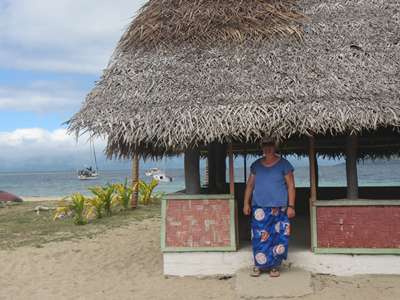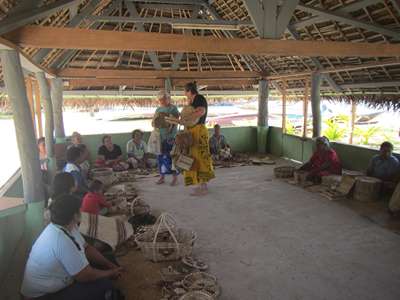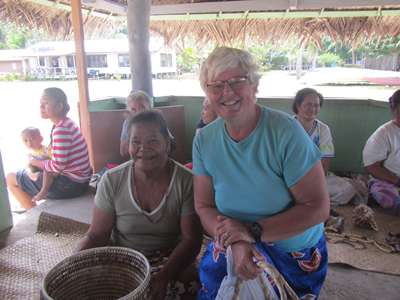Kioa Island

16:40.225S 179:54.205E Monday 29th June 2015 Distance run: 5 nmiles After a peaceful night in Buca Bay, we lifted the anchor on Saturday morning and motored back round to Kioa Bay to take another look with a view to anchoring for the day if conditions weren’t too bad. In fact the lumpy seas had died right down and so we dropped the anchor behind the reef on the eastern side of the bay which seemed to offer the best shelter.
Calmer in the bay when we returned. S-F and BN anchored in the east of the bay. Although part of Fiji, Kioa Island is owned and inhabited by Polynesians originally from the island of Vaitupu in Tuvalu. They bought the island in 1947 for $15,000 using money they had earned during WWII working for American soldiers. The village in Kioa Bay is the only settlement on the island, with around 400 people. Residents of the island were granted Fijian citizenship ten years ago, and a further 600 now live and work on one of the larger islands of Viti Levu or Vanua Levu. We took the dinghy ashore, and together with Bear and Pepe set off to find the chief of the village to present our gifts of kava and to ask permission to anchor in the bay and explore the village and island. The ritual of sevusevu is not carried out here as the people are not indigenous Fijians, but the custom of meeting the chief, presenting a gift and asking permission to stay is similar. A young man who was on the beach took us to a covered area where a group of men were sitting and handed us over to Lotto – the older man whom we assumed was the chief. It turned out, however, that Lotto is the Chairman of the Council and apparently the person in charge. There are three chiefs in the village, but the Council makes all the decisions. He invited us up to sit in the covered area and welcomed us, accepted our kava, and told us a little about the history of the island and its people. He then invited us to drink some kava with him, which we did. The drink was made from crushed kava root in a cloth soaked and squeezed in water in a plastic washing up bowl, and then served in half a coconut shell (the same one) to each of us in turn. It must be drunk all in one go, and took about five big slugs to get down, but wasn’t too bad, just tasted of muddy water with a mildly peppery aftertaste. After each person drank, the men clapped three times. Once this was done, Lotto thanked us and wished us an enjoyable stay. We took this as our dismissal and thanked him and left. We spent the next couple of days exploring the village and meeting some of the people who were very friendly and interested to hear about our travels. At the Council office building we met a young man called Sasemio (I think!) who was the youngest member of the Council, responsible for Youth and Women. He had been away at school/college and only a year back on the island. He told us about life in the village, and clearly seemed to be missing some of the creature comforts – like a constant supply of electricity for example. The village has a generator to which most of the houses are wired, but it is only run from 7-11 p.m. He explained that the villagers don’t need it during the day, as they don’t have fridges (again said with a wincing look!)
From the boat.
Some parts of the village have concrete pathways. Some accommodation open to the elements.
Water tanks fed from a reservoir up in the hills. Cooking areas usually outside the main living area.
Village children like to pose for photos. This fallen tree provides a great place to play.
Most houses are sturdily built from wood. A pool table inside an otherwise ramshackle building!
Fishermen returning from the day’s fishing. Older kids off to boarding school on Taveuni. We had a look around the Primary School (closed for holidays) where the children go until they are thirteen. We spoke to Tom who goes to boarding school on Taveuni, and to a young lady in her final year of Primary who said she thinks that next year she will go to stay with her sister in Suva and go to secondary school there.
Children played in the school grounds. The largest building at the Primary School, and playground.
One of the Year 6 classrooms.
A new pre-school building, not yet in use. With covered area for outdoor play.
Good to see a book corner taking shape. No school bell – this drum summons the children to school.
View from the school playground. Traditional outrigger canoes are still used for fishing. We wandered along the beach and found, just around the corner and out of sight (and smell!) of the village, the piggery. The pigs are kept in wooden cages on stilts at the edge of the beach, in the shade of the trees, where their muck can just fall through the floor of the cage into the sea. At low tide their feed is brought by wheelbarrow along the beach, and at high tide it is brought by canoe. I decided at this point that I did not really fancy snorkelling on the nearby reef after all.
Pig sty Kioa style. On Sunday we dressed in our Fijian best – Steve sporting his new sulu (sarong-type skirt) and went ashore to attend the morning church service. The large church was pretty full, with children sitting on rush mats at the sides. I almost made the mistake of sitting on the men’s side of the church as I automatically followed Steve to a seat, but was gently guided over to the women’s side. We did not understand much of the service, but a few words of English occasionally cropped up and we were welcomed and blessed by the minister. After the service one of the older ladies came over to speak to us and we asked when and where we might see some of the handicrafts made by the women of the village. She asked when would be good for us and said she would pass the word around.
The men in their sulus. All dressed up in our Sunday best!
“Talofa” means “Hello, welcome”. Sure enough, when we went ashore at 10 a.m. on Monday morning, the hut near the beach was full of ladies who had laid out their goods for sale. We had a very enjoyable time choosing some of the handicrafts and trying to ensure that each of the ladies made at least one sale. The goods were not at all expensive, and we felt this was our way of contributing to the village. The ladies were all very cheerful and friendly and joined in with our jokes and everyone, including us, went away happy.
Shopping for handicrafts. |
